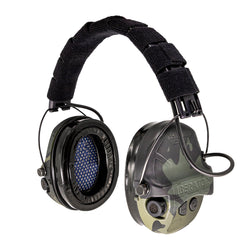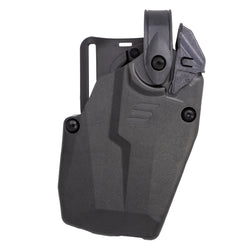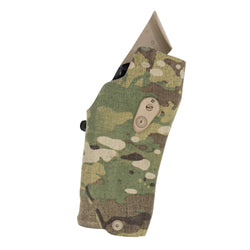We have seen the world become more violent, with mobs swarming vehicles, increased carjacking, and ambushes on our law enforcement officers. With the increase in violence and the amount of time we spend in and around our vehicles, we need to make sure we have the skills to defend ourselves and our families.
A plan for how to respond, backed by training, greatly increases your survivability in a deadly-force encounter. You don’t want to try to figure it out when the situation happens.

The are many terms for fighting in and around vehicles. At War HOGG Tactical, we keep it simple and call it all vehicle tactics or vehicle counter ambush for our military and law enforcement students. We apply our real-world experience to train law abiding citizens, military, and law enforcement agencies using a building block teaching style to enhance their vehicle-tactics skills.
The purpose of these vehicle tactics articles is to educate you on some different tactics when fighting in and around a vehicle. REMEMBER: don’t bail out of the vehicle unless it’s disabled! Your vehicle’s maneuverability equals survivability. If you bail out and the vehicle is still mobile, you have greatly reduced your mobility options.
Vehicle Tactics Marksmanship Training
The first priority when training vehicle tactics is proficiency in marksmanship and gun handling skills in and around a vehicle. For me, this starts with being able to shoot from a seated position. I start with a folding chair at the house and work my dry fire techniques.
I begin with the pistol on my strong side, making sure I don’t sweep or flag my leg during the draw. Once I’m comfortable addressing a threat directly in front of me, I’ll angle the chair to 45 and 90 degrees and repeat the drills. I then take my folding chair and head to the range for some live fire practice.

Barricade Work
The next step in our build block methodology is training with barricades. If you have access to a V-TAC barricade, that would be great. If not, you can use a pickle barrel; if that’s not available, you can always use your folding chair for a barricade. Having these skills will improve your use of cover around your vehicle.
Holster Placement Inside A Vehicle
Efficiently and safely securing your firearm in a vehicle is a critical skill that must be practiced.
I believe a pistol belongs in a holster while you’re in a vehicle. Some people like to place them in different compartments in the vehicle; this will definitely increase your time to access your firearms. Others place them between the seat or under their leg for “easier access.”
The problem with this technique is that if you have to do some type of evasive driving, there is a chance your pistol could get dislodged and wind up on the floorboard.
The appendix vs. strong-side debate comes up a lot. In a vehicle, there’s no need to conceal the pistol, so expose your pistol for easier access. I prefer my strong side.
The issue I have with appendix carry is that sometimes my pistol grip gets behind the seatbelt. The problem comes in when I might have to do some evasive driving, and the seat belt locks up, pinning my pistol under the seat belt.
Having A Carbine in your vehicle
If you plan to carry a carbine in your vehicle, decide where to stow it and how you’ll employ it quickly.
For a lot of my law enforcement officers, most of you carry them in the trunk. The problem I have with this setup is, what happens if the trunk gets damaged and you can’t open it? If possible, I would recommend some type of “black rack” system in the front compartment.
For my civilians, find the best place to secure your carbine if you’re going to carry one. Remember not to leave it in the open for someone to see it and break into your vehicle and steal it.

“Cruiser ready” is when you have a magazine in the carbine but not a round in the chamber. This is typically how law enforcement carry their carbines in their vehicle. Officers need to practice charging their carbines and engaging a target. It can sound simple, but during that high-stress moment, if you have never practiced it, chances are you are not going to do it.
How you stow the sling matters. A properly stowed sling can be the difference between getting your carbine out of the vehicle and getting it hung up where now it can’t be employed. I would recommend your stock be completely collapsed, but practice unstowing your sling, putting it around your neck, and extending the stock to the proper length of pull.
Barrel length also affects whether a carbine is even feasible to have a carbine in your vehicle and how easily you can employ it. Practice with your carbine to figure out the best technique for your vehicle and carbine length.
Vehicle Counter Ambush
The vehicle ambush can come in many different forms, everything from a carjacking to a firearms-initiated ambush against a law enforcement officer. You can’t predict every single scenario but having some type of plan will definitely help your situation in that moment of high stress. Below are vehicle-centered techniques to increase survivability.
Drive Forward
The drive forward is just that; there is a threat to your front that warrants deadly force. Use that 3,000-plus-pound vehicle to drive forward towards the threat and out of the danger area.
Vehicle Rub
Use your vehicle and another solid object (another vehicle, wall, etc.) to shield and strike the threat between you and that object, then drive away from the danger area.
Back Out
If you have space, reverse your vehicle out of the situation. You have some options depending on the situation.
You could back out to a safe distance, conduct a J turn, and leave the area.
If you are taking effective fire, try to get low or lie towards the passenger seat. Use your backup camera and create distance between you and the threat. This is a classic situation where the trunk could be damaged, and the ability to retrieve the carbine is not possible. This technique also shows how mobility equals survivability.
The last option is, once you are a safe distance back from the threat, get your carbine in action.
Always be learning
There’s a lot of information about vehicle tactics out there. Shooters beware, if someone does not give you the why or does not sound right, that technique might not be sound. Social media is also full of vehicle‑tactics content, so be careful with some of those techniques that might get you killed in a deadly force situation.
If your agency or unit is looking for vehicle tactics training, reach out to us at warhogg.com.
Stay tuned for part II.
Train Hard, Stay Safe and see you “On The Range” – Rick











